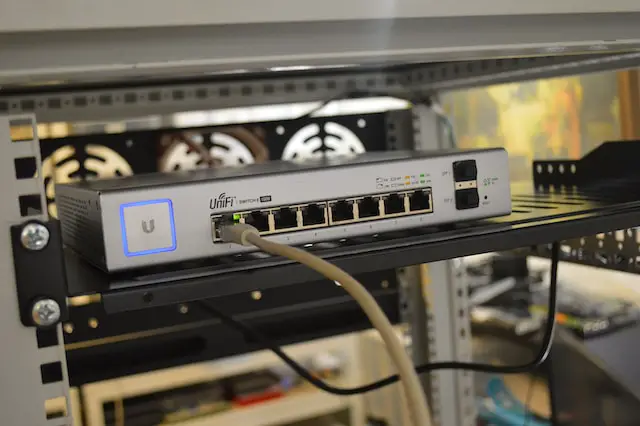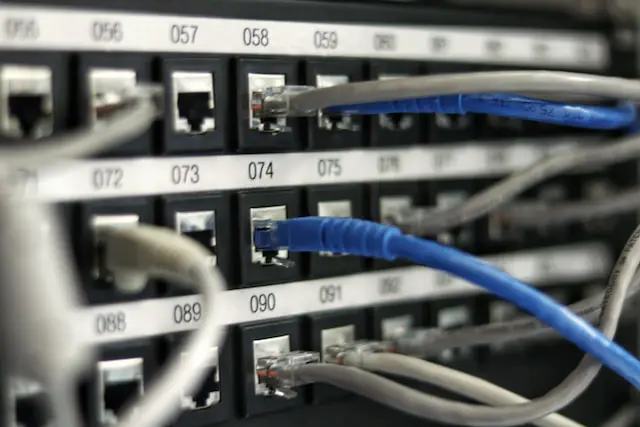Both gateways and bridges are essential components of network communication. The main difference between them is that a gateway operates at the application layer while a bridge works at the data link layer. In general, gateways are used to connect different networks with different protocols, whereas bridges are used to connect devices within the same network. Routers serve as intermediaries that forward data packets along networks.
What is a Gateway?
(Image by Luis Wilker WilkerNet from Pixabay )

A gateway is a device that connects two networks and acts as an entry or exit point for data. It translates the information from one network protocol to another, enabling communication between systems with different architectures. Gateways are commonly used in homes, offices, and businesses to connect local area networks (LANs) to wide area networks (WANs), such as the internet.
Gateways can be hardware-based or software-based. Hardware gateways come in various shapes and sizes – they can be standalone devices or integrated into other equipment like routers or modems. Software gateways are programs that run on computers or servers, allowing them to function as gateways.
The primary functions of a gateway include packet filtering, security management, and routing protocols. It performs these tasks by analyzing incoming data packets and forwarding them to their intended destination based on criteria such as IP address, port number, or content type.
A Gateway is an essential component of any network infrastructure. Its ability to connect multiple networks while ensuring secure transmission of data makes it an indispensable tool for modern-day communications.
What is a Bridge?
(Photo by Thomas Jensen on Unsplash )

A bridge is a networking device that operates at the data link layer of the OSI model. Its primary purpose is to connect two different networks together and helps in exchanging information between them. A bridge receives packets from one network, reads their MAC addresses, and then forwards them to the other network based on those addresses.
Unlike a hub, which broadcasts all incoming packets to every connected device, a bridge only sends packets where they need to go. This filtering process improves network performance by reducing unnecessary traffic.
Bridges are commonly used in local area networks (LANs) where there are multiple segments or subnets within the same physical location. They can also be used in wireless networks when connecting wired and wireless devices together.
Bridges help improve network efficiency by breaking up larger broadcast domains into smaller ones while still allowing for communication between them.
What is a Router?
A router is a networking device that connects different networks together. It functions as a gateway to both the internet and other networks, such as a local area network (LAN). Routers are responsible for directing traffic between these different networks.
Unlike switches or hubs, routers use IP addresses to route data packets from one network to another. When data packets arrive at the router, it examines the destination address of each packet and determines where it needs to be sent next in order to reach its final destination.
Routers can also provide additional features beyond just routing data packets. They can act as firewalls by blocking unauthorized access to a network, and they can prioritize certain types of traffic over others based on quality of service (QoS) settings.
Many home users have routers built into their modems provided by their Internet Service Provider which allows them to connect multiple devices such as laptops, tablets and smartphones wirelessly via Wi-Fi within their household.
Gateway Vs. Bridge – Key differences
A gateway and a bridge are two networking devices that serve different purposes. A gateway connects networks using different protocols, while a bridge links networks that use the same protocol.
A gateway is typically used to connect a local area network (LAN) to the internet or another wide area network (WAN). It translates data between these networks so that they can communicate with each other. In contrast, a bridge is used to connect two LANs together in order to extend their coverage.
Another key difference between gateways and bridges is their level of intelligence. A gateway often performs complex tasks such as packet filtering, routing, and translation of IP addresses while a bridge simply forwards packets from one segment of a network to another without making any changes.
Gateways are also capable of working at multiple layers of the OSI model whereas bridges operate only at Layer 2 – the Data Link layer. This means that gateways can perform more sophisticated functions like converting between different transport protocols or translating application-layer data.
In summary, both gateways and bridges play crucial roles in modern computer networking but have distinct differences in terms of their functionality and purpose. Understanding these differences will help you make informed decisions about which device best fits your networking needs.
Why is gateway used?
Gateways are an essential component of many networks. They act as a bridge between two or more different network protocols, allowing communication to take place between them. In other words, gateways help in the translation of data from one format to another.
One reason why gateways are used is that they can connect different types of networks that operate on different protocols. This means that if you have multiple networks with varying protocols, a gateway can create a connection between them and allow for seamless communication.
Another reason why gateways are used is because they provide enhanced security measures by acting as a barrier against unauthorized access attempts. They also offer better control over network traffic flow and can implement policies to ensure efficient data transfer.
Moreover, when it comes to remote access, gateways play an important role in enabling secure connections into private corporate networks via the internet. By doing so, organizations can maintain secure communications with their workforce anytime and anywhere.
Gateways remain indispensable components of modern-day networking infrastructure due to their ability to interconnect various systems while maintaining security standards and ensuring optimal performance levels.
The advantages and disadvantages of a gateway
Advantages of a gateway:
- Protocol translation: A gateway can translate data between different protocols, allowing devices on different networks to communicate with each other.
- Network security: A gateway can act as a security barrier between networks, blocking unauthorized traffic and protecting against external threats such as hackers and malware.
- Load balancing: A gateway can distribute traffic across multiple servers, helping to balance the load and prevent any one server from becoming overwhelmed.
- Filtering: A gateway can filter out unwanted traffic, such as spam and other malicious content, before it reaches the destination network.
- Centralized management: A gateway can provide centralized management of network resources, making it easier to monitor and control network traffic.
Disadvantages of a gateway:
- Performance overhead: The additional processing required to translate protocols or filter traffic can add overhead to network performance, potentially slowing down data transfer speeds.
- Complexity: Configuring and managing a gateway can be complex and requires specialized skills and knowledge, which can be a challenge for smaller organizations with limited IT resources.
- Single point of failure: Because a gateway is a single point of entry and exit for network traffic, any failure or downtime can result in a complete loss of network connectivity.
- Cost: Gateways can be expensive to implement and maintain, especially for organizations with large or complex networks.
- Security risks: If not properly configured and maintained, a gateway can also introduce security risks, such as allowing unauthorized access to sensitive data or becoming a target for hackers and other malicious actors.
The advantages and disadvantages of a bridge
Advantages of a bridge:
- Cost-effective: Bridges are typically less expensive to implement and maintain compared to gateways.
- Simple configuration: Bridges are easier to configure and manage than gateways, making them a good choice for smaller networks or organizations with limited IT resources.
- Improved network performance: Bridges can improve network performance by reducing the amount of traffic on each segment of the network, helping to prevent network congestion and improve data transfer speeds.
- Greater network flexibility: Bridges can connect multiple LANs and allow them to communicate with each other, providing greater network flexibility and enabling more efficient use of network resources.
Compatibility: Bridges are compatible with a wide range of network protocols, making them a versatile and adaptable networking solution.
Disadvantages of a bridge:
- Limited functionality: Bridges typically do not provide additional features such as security, filtering, or load balancing.
- Inability to connect different network types: Bridges can only connect networks that use the same protocol, such as Ethernet or Wi-Fi.
- MAC address limitation: Bridges use MAC addresses to forward data between networks, which can limit the number of devices that can be connected to a single network segment.
- Single broadcast domain: Bridges create a single broadcast domain, which can result in increased network traffic and potential performance issues.
- Limited scalability: Bridges may not be able to handle the increased traffic and complexity of larger or more complex networks, which can limit their scalability.
Featured Image By – Jordan Harrison on Unsplash









